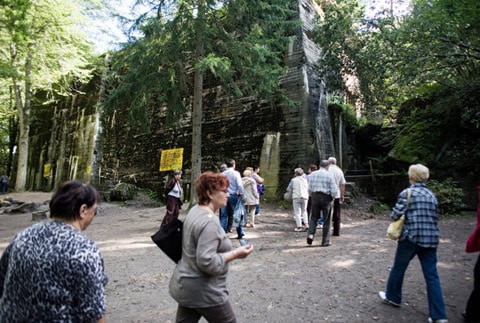
But while Poland went to great lengths to preserve the memory of Nazi death camps like Birkenau, the significance of this historic outpost was largely lost. Under lease to a private company, the Wolf’s Lair was transformed into a place to take pottery lessons and play paintball. Although most people still come here for the historic value, there is little in the way of educational materials, and at least one nod to the past is more kitschy than thoughtful: visitors can pose for photos wearing Nazi uniforms.
Now, however, the Polish government has decided that the Wolf’s Lair holds valuable history lessons that need to be preserved, especially amid signs that right-wing ideologies of hate and blame are taking root in corners of Europe. As a requirement of issuing a new lease, the Polish Ministry of Culture and National Heritage has demanded that the company running the site transform it into a historical and educational destination with detailed outdoor exhibits and a museum.
“At this moment, one does not feel the tragic dimension of this place,” said Tomasz Chincinski, a historian who is working on the project. “We need to work on new ways of telling history, to make young generations want, need, to learn it and understand it.”
Hitler built the Wolf’s Lair as his headquarters on the Eastern front; it covered over 600 acres of remote woodland that was once the site of estates for the landed gentry of Prussia. The compound was a self-contained world of 200 buildings, including bunkers, barracks and power plants, all serving 2,000 of Hitler’s men (and a few women).
In 1945, the Germans, retreating from advancing Soviet forces, tried to blow up the buildings, with limited success. After the war, Poland opened the outpost to tourists, but did little to help educate those who visited, mainly displaying photographs of the headquarters from Hitler’s time there.
The breakup of the Soviet bloc did not change much at the Wolf’s Lair. The newly liberated Polish state leased it to a private company called Wolf’s Nest.
The company turned bunkers into a restaurant and a hotel, cleared some tourist trails of debris, and made the bunker that had belonged to Gen. Alfred Jodl — who was tried at Nuremberg and hanged — into an indoor shooting range.
Over time, according to Jan Oldakowski, 40, a director of the popular Warsaw Uprising Museum, the Wolf’s Lair become a “grotesque Disneyland.” Aside from the restaurant and hotel, the site is in disrepair. Most of the bunkers are hidden beneath carpets of moss. The trails are in poor condition and are not handicapped accessible.
“The biggest change they’ve introduced in the last decade was getting a cash machine here,” said Lukasz Joachymek, 36, who has been showing German tourists around the Wolf’s Lair for 11 years as a freelance tour guide.
Luiza Jankowska, 22, a political science student from Gdansk, Poland, who visited here recently, said she came because she wanted to see the place where Claus von Stauffenberg, a top German official, tried to assassinate Hitler on July, 20, 1944.
She was disappointed by the site’s dilapidated state. Nevertheless, she said, “It’s fascinating to be in a place that could have changed the history of the Second World War and, who knows, maybe even our lives.”
Jan Zaluska, 65, Wolf’s Nest’s director, said the site’s poor condition was partly a result of years of uncertainty over who owned the site, Ketrzyn County or an agency of the federal government that oversees forests. “It took years before the matter was settled,” he said. “Before that, we could not think about investing.”
Now that the forestry agency’s ownership has been established, he said, Wolf’s Nest is ready to proceed. Mr. Zaluska defended the company, saying that the Wolf’s Lair site might have been even more commercial under different operators. In 1991, an American company proposed building a casino there, he said, though that company was also going to replicate Hitler’s office.
But Mr. Zaluska said that in February, when Wolf’s Nest was awarded another two-decade lease, it agreed to respect the site’s standing as “a witness to history, a historical site where the fate of the Second World War was decided.”
The company has promised to restore a movie theater to show documentaries about the war and is coordinating with forestry officials and with historians from the Museum of the Second World War — scheduled to open in Gdansk in 2014 — to construct a permanent outdoor exhibition about what happened at the Wolf’s Lair. The company also plans to create trails to guide visitors through the bunkers’ remains, encouraging visitors to familiarize themselves with the outpost’s history.
The goal of the exhibits, the cultural ministry official said, is to allow people to see how beliefs like Nazi ideology can warp a society. The exhibits will try to tell the story of everyday life at the command post and of the horrifying decisions that were made here.
For Wiebke Soor, 51, and her husband, Matthias, 48, from Germany, the site was worth visiting even before its reconstruction. They said they needed to see with their own eyes a place where the unimaginable had happened.
“On the other hand, it shows us what a long way we’ve come since then,” Mr. Soor said.
But his wife shook her head and said: “Yes, but we all still need a reminder. History likes to repeat itself.”
Source: The New York Times
Photos: Getty Images and Adam Lach/The New York Times

